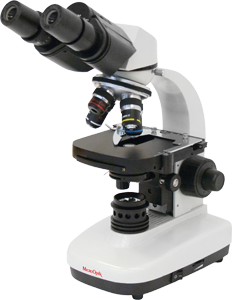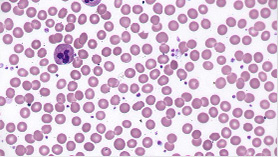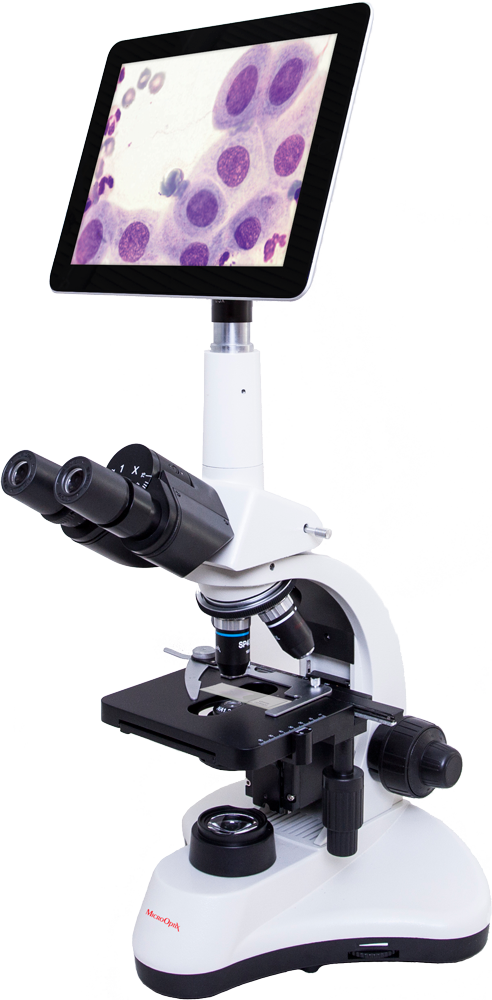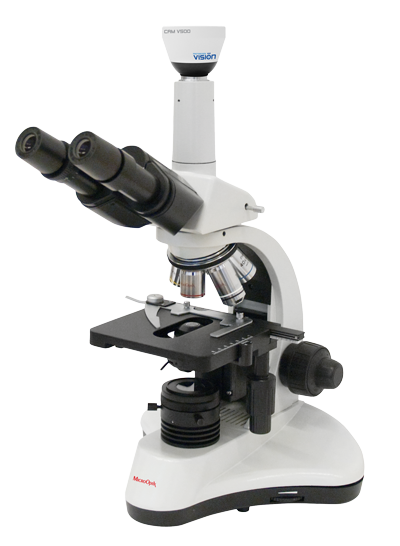Choosing a microscope is simply a question of getting the right tool for the job. Since microscopes are put to such a wide range of uses, there are naturally many types of microscopes and specialized accessories. This is a brief guide to the types of microscopes that MixroOptix offers and the applications for which they are commonly used.
Your application is the most important factor in deciding which microscope to use. What you need to see and what you want to do with that image will determine what kind of microscope you need. There are two basic types of optical microscopes: compound and stereo. If you need very high magnification to view the internal structures of cells, you would most likely use a compound microscope. If you need to examine solder joints on circuit boards or other relatively large objects, you would probably use a stereo microscope.
Within each of these applications, however, there can be far more demanding requirements; a researcher studying the functions of neurons will require a far more sophisticated instrument than a high school biology teacher introducing students to cellular structures for the first time. If you have a very specific application, you may need a highly specialized microscope or special accessories. With our wide range of microscopes and accessories, MicroOptix can help you configure an instrument for almost any application.
Compound microscopes are what most people visualize when they think about microscopes.

MX 50 Binocular microscope
They have a number of objectives (the lens closest to the object being viewed) of varying magnifications mounted in a rotating nosepiece. Typically the range of magnification on a compound microscope is between 40x and 1000x, although some are capable of higher or lower magnifications.
 |
 |
 |
||
| 10X Magnificationtion | 40X Magnificationtion | 100X Magnificationtion |
Because only one objective is used at a time, the viewer sees a two-dimensional image of the specimen (usually reversed and upside-down).
All MicroOptix biological microscopes are compound microscopes. These microscopes are used by laboratories, universities and hospitals to look at biological specimens for research and diagnostics.
Unlike a compound microscope that offers a 2-dimensional image, stereo microscopes give the viewer an erect (upright and un-reversed) stereoscopic (3-dimensional) image. This is particularly useful for biologists performing dissections, technicians repairing circuit boards, paleontologists cleaning and examining fossils, or anyone who needs to work with their hands on small objects.
_no_cam.png)
MX 1150 (T) Stereo microscope
Most stereo microscopes are used at magnifications from 5x to 50x, but with the proper microscope and accessories, magnifications up to approaching 400x can be achieved. Stereo microscopes are typically used in work or study environments that require users to work with the specimen with their hands or with tools under the microscope. Usually low magnification however, some models can achieve 300X with decent resolution.
For many applications the ability to capture, display, and preserve specimen images is of equal or greater importance than actually viewing the specimen through the eyepieces. Photomicrography (35mm and other chemical formats) has been a common option on microscopes for decades, but the recent development of relatively inexpensive CCD (charged couple device) video and digital cameras has greatly increased both the popularity and flexibility of microscope imaging.

MX100 video microscope with computer-camera
Instead of clicking through slides during a lecture, university professors can now display real-time video images on projection televisions; petroleum geologists can e-mail images of core samples to their laboratories from remote locations around the world; oncologists can refer to CD or on-line catalogues of cell images to help them make faster and more accurate diagnoses. Whether your application calls for 35mm, large-format Polaroid, video, or digital imaging, MicroOptix can provide you with the appropriate microscope and accessories.
There are many different methods for capturing, displaying, and recording microscope images, and each has its own advantages and disadvantages. It would be impossible to cover all of these options here (Check the Photo/Video Accessories page for more details), but one basic piece of information will be important in selecting your microscope: While it is possible to mount a camera on a monocular or binocular microscope (a binocular microscope has two eyepieces, but is not necessarily a stereo microscope), it is far better to use a trinocular microscope designed for camera work.
Trinocular models have two eyepieces for normal viewing, plus a third "phototube" on which you can mount a camera without interfering with the normal operation of the microscope.

MX 300 trinocular microscope with digital camera
We hope this brief outline can help you to determine which kind of microscope your application requires. If you would like further information on any of these topics, or if you would like help in configuring the right microscope for your application, simply contact us and we will be happy to assist you.